Showing Spotlights 1881 - 1888 of 2783 in category All (newest first):
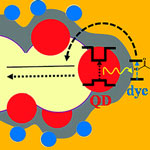 While the dye sensitized photovoltaic cell is a fairly mature design, researchers are still trying to improve its efficiency with various techniques, including structuring nanoporous electrodes to provide higher surface area and better charge transport, replacement of the liquid electrolyte by a solid one in order to prevent the electrolyte evaporation, and ways to widen the narrow absorption spectra of molecular dyes. In a standard DSSC, an organic molecule adsorbed on the surface of a porous electrode absorbs light and then initiates the charge separation process eventually leading to generation of photocurrent. One major difficulty in such cells is that very few dyes can absorb a broad spectral range, essentially covering the solar spectrum. In contrast, broad spectral coverage is an inherent property of semiconductor nanocrystals. The latter, however, turn out to do a rather lousy job in separating the charges. Researchers in Israel have now presented a new configuration for quantum dot sensitized DSSCs via a FRET process.
While the dye sensitized photovoltaic cell is a fairly mature design, researchers are still trying to improve its efficiency with various techniques, including structuring nanoporous electrodes to provide higher surface area and better charge transport, replacement of the liquid electrolyte by a solid one in order to prevent the electrolyte evaporation, and ways to widen the narrow absorption spectra of molecular dyes. In a standard DSSC, an organic molecule adsorbed on the surface of a porous electrode absorbs light and then initiates the charge separation process eventually leading to generation of photocurrent. One major difficulty in such cells is that very few dyes can absorb a broad spectral range, essentially covering the solar spectrum. In contrast, broad spectral coverage is an inherent property of semiconductor nanocrystals. The latter, however, turn out to do a rather lousy job in separating the charges. Researchers in Israel have now presented a new configuration for quantum dot sensitized DSSCs via a FRET process.
Feb 23rd, 2010
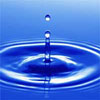 Currently, potential and actual applications of nanotechnology in environmental technologies are receiving considerable attention worldwide. Relevant applications include environmental remediation (air, water and soil), monitoring, and resource saving (energy and materials). These technologies are not only intended for markets in wealthy countries, including in Europe, the USA and Japan, but may also be particularly useful for protecting consumers and the environment in emerging economies and developing countries. Furthermore, research groups and companies in emerging economies and developing countries are increasingly active in R+D and manufacturing environmental nanotechnologies, as part of a national knowledge economy. As an example, the ICPC-NanoNet project supports international research cooperation in environmental nanotechnology between the European Union and International Cooperation Partner Countries to the EU. This article focuses on the case of nanotechnology for water purification.
Currently, potential and actual applications of nanotechnology in environmental technologies are receiving considerable attention worldwide. Relevant applications include environmental remediation (air, water and soil), monitoring, and resource saving (energy and materials). These technologies are not only intended for markets in wealthy countries, including in Europe, the USA and Japan, but may also be particularly useful for protecting consumers and the environment in emerging economies and developing countries. Furthermore, research groups and companies in emerging economies and developing countries are increasingly active in R+D and manufacturing environmental nanotechnologies, as part of a national knowledge economy. As an example, the ICPC-NanoNet project supports international research cooperation in environmental nanotechnology between the European Union and International Cooperation Partner Countries to the EU. This article focuses on the case of nanotechnology for water purification.
Feb 22nd, 2010
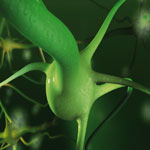 Nanobiotechnology is essentially different in many aspects from other areas of nanotechnology such as nanoelectronics or nanomaterials. It is certainly the most complex sub-area of nanotechnology. Last month, EuroNanoBio - a Support Action funded under the 7th Framework Programme of the European Union - has issued its report on a conceptual framework and a tool box to structure the European capacity in nanobiotechnology. The EuroNanoBio partners explored the definition, establishment and further development of a European scale infrastructure on nanobiotechnology and the associated realistic implementation plan. It aimed at defining not only the key features of a potential European infrastructure in nanobiotechnology, but it has also established the way it should be designed.
Nanobiotechnology is essentially different in many aspects from other areas of nanotechnology such as nanoelectronics or nanomaterials. It is certainly the most complex sub-area of nanotechnology. Last month, EuroNanoBio - a Support Action funded under the 7th Framework Programme of the European Union - has issued its report on a conceptual framework and a tool box to structure the European capacity in nanobiotechnology. The EuroNanoBio partners explored the definition, establishment and further development of a European scale infrastructure on nanobiotechnology and the associated realistic implementation plan. It aimed at defining not only the key features of a potential European infrastructure in nanobiotechnology, but it has also established the way it should be designed.
Feb 19th, 2010
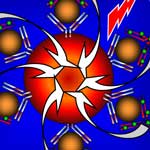 In many diagnostic processes, the detection of several protein markers is required. Rather than performing several sequential analysis steps, a multiplexed approach allows the simultaneous measurement of multiple biomarkers from the same blood sample. The convergence of nanotechnology, microtechnology, microfluidics, photonics, signal processing, and proteomics allows for the development of increasingly sophisticated and effective multiplexed point-of-care diagnostic devices. The detection of protein biomarkers can done with an optical multiplexing approach that uses dye particles of different colors. In contrast to conventional fluorescence dyes, quantum dots generate a much more powerful fluorescent signal which provides a large increase in sensitivity compared to other methods. Quantum dots are also available in multiple colors, allowing the investigators to tag each antibody with a uniquely colored quantum dot. Researchers have now demonstrated a novel and fast quantum dot-based FRET technique that is suitable for multiplexed ultrasensitive detection.
In many diagnostic processes, the detection of several protein markers is required. Rather than performing several sequential analysis steps, a multiplexed approach allows the simultaneous measurement of multiple biomarkers from the same blood sample. The convergence of nanotechnology, microtechnology, microfluidics, photonics, signal processing, and proteomics allows for the development of increasingly sophisticated and effective multiplexed point-of-care diagnostic devices. The detection of protein biomarkers can done with an optical multiplexing approach that uses dye particles of different colors. In contrast to conventional fluorescence dyes, quantum dots generate a much more powerful fluorescent signal which provides a large increase in sensitivity compared to other methods. Quantum dots are also available in multiple colors, allowing the investigators to tag each antibody with a uniquely colored quantum dot. Researchers have now demonstrated a novel and fast quantum dot-based FRET technique that is suitable for multiplexed ultrasensitive detection.
Feb 17th, 2010
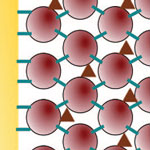 Solar-powered splitting of water promises an attractive, clean energy source and numerous research projects around the world are working on making this process sufficiently efficient - reducing the systems' cost and extending their lifetimes - to be able to compete with dirty carbon fuels on an industrial scale. Natural photosynthesis uses chlorophyll to absorbe visible light and many solar hydrogen cells are imitating this process by using light-sensitive organic dye molecules as light absorbers and then transfer the absorbed energy to a catalyst that reduces protons to hydrogen. Researchers in the UK have now shown that an inexpensive and environmentally benign inorganic light harvesting nanocrystal array can be combined with a low-cost electrocatalyst that contains abundant elements to fabricate an inexpensive and stable system for photoelectrochemical hydrogen production.
Solar-powered splitting of water promises an attractive, clean energy source and numerous research projects around the world are working on making this process sufficiently efficient - reducing the systems' cost and extending their lifetimes - to be able to compete with dirty carbon fuels on an industrial scale. Natural photosynthesis uses chlorophyll to absorbe visible light and many solar hydrogen cells are imitating this process by using light-sensitive organic dye molecules as light absorbers and then transfer the absorbed energy to a catalyst that reduces protons to hydrogen. Researchers in the UK have now shown that an inexpensive and environmentally benign inorganic light harvesting nanocrystal array can be combined with a low-cost electrocatalyst that contains abundant elements to fabricate an inexpensive and stable system for photoelectrochemical hydrogen production.
Feb 16th, 2010
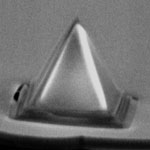 Many nanotechnology applications are plagued by very poor wear resistance of device components at the nanoscale. Gears, bearings, and liquid lubricants can reduce friction in the macroscopic world, but the origins of friction for small devices such as micro- or nanoelectromechanical systems require other solutions. Despite the unprecedented accuracy by which these devices are nowadays designed and fabricated, their enormous surface-volume ratio leads to severe friction and wear issues, which dramatically reduce their applicability and lifetime. Although there is a significant amount of research work going on in the area of nanoscale friction, at present there is much less research conducted on nanoscale wear. Researchers have now demonstrated extremely low wear rates at the nanoscale, representing a technological breakthrough for numerous applications in emerging fields such as nanolithography, nanometrology, and nanomanufacturing.
Many nanotechnology applications are plagued by very poor wear resistance of device components at the nanoscale. Gears, bearings, and liquid lubricants can reduce friction in the macroscopic world, but the origins of friction for small devices such as micro- or nanoelectromechanical systems require other solutions. Despite the unprecedented accuracy by which these devices are nowadays designed and fabricated, their enormous surface-volume ratio leads to severe friction and wear issues, which dramatically reduce their applicability and lifetime. Although there is a significant amount of research work going on in the area of nanoscale friction, at present there is much less research conducted on nanoscale wear. Researchers have now demonstrated extremely low wear rates at the nanoscale, representing a technological breakthrough for numerous applications in emerging fields such as nanolithography, nanometrology, and nanomanufacturing.
Feb 15th, 2010
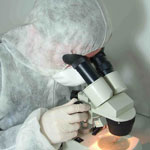 The discussion about nanotechnology related safety issues so far has focused mainly on three areas - consumers getting exposed to products containing nanomaterials; nanomaterials getting released into the environment and potentially entering the food chain; and industrial workers being exposed to nanomaterials during the production process. There is an increasing number of reports and research papers dealing with these issues. Interestingly, while surveys of nanotechnology safety practices have concentrated on industrial settings, the safety issues of a significant number of people working with nanomaterials have not been addressed in a concerted matter - the researchers at university and private research laboratories who are doing all the early stage research and development. According to a survey conducted by a Spanish research group, it appears that the nanotechnology research community is not exactly at the forefront when it comes to following, not to mention setting, standards for safe practices for handling nanomaterials.
The discussion about nanotechnology related safety issues so far has focused mainly on three areas - consumers getting exposed to products containing nanomaterials; nanomaterials getting released into the environment and potentially entering the food chain; and industrial workers being exposed to nanomaterials during the production process. There is an increasing number of reports and research papers dealing with these issues. Interestingly, while surveys of nanotechnology safety practices have concentrated on industrial settings, the safety issues of a significant number of people working with nanomaterials have not been addressed in a concerted matter - the researchers at university and private research laboratories who are doing all the early stage research and development. According to a survey conducted by a Spanish research group, it appears that the nanotechnology research community is not exactly at the forefront when it comes to following, not to mention setting, standards for safe practices for handling nanomaterials.
Feb 11th, 2010
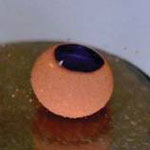 In contrast with microchannel-based fluidics, the manipulation of discrete droplets without using microfluidic channels is a new field. Here, a liquid droplet is not confined to a closed channel and there is no risk of being adsorbed on a channel wall. A liquid marble, a liquid encapsulated by non-wetting powder, could be a new microfluidic device, which is especially useful for handling single liquid droplet. One of the challenges for using liquid marbles as microfluidic devices is the communication between the liquid droplet and the external devices/materials. Researchers in Australia have been trying to develop 'field-responsive smart liquid marbles' which can be opened and closed reversibly on demand, such that the liquid in the marble can be easily taken and other liquid can also be added into the marble easily. The mechanically robust magnetic liquid marble, prepared by coating a water droplet with highly hydrophobic magnetite nanoparticles, can be actuated magnetically.
In contrast with microchannel-based fluidics, the manipulation of discrete droplets without using microfluidic channels is a new field. Here, a liquid droplet is not confined to a closed channel and there is no risk of being adsorbed on a channel wall. A liquid marble, a liquid encapsulated by non-wetting powder, could be a new microfluidic device, which is especially useful for handling single liquid droplet. One of the challenges for using liquid marbles as microfluidic devices is the communication between the liquid droplet and the external devices/materials. Researchers in Australia have been trying to develop 'field-responsive smart liquid marbles' which can be opened and closed reversibly on demand, such that the liquid in the marble can be easily taken and other liquid can also be added into the marble easily. The mechanically robust magnetic liquid marble, prepared by coating a water droplet with highly hydrophobic magnetite nanoparticles, can be actuated magnetically.
Feb 10th, 2010
 While the dye sensitized photovoltaic cell is a fairly mature design, researchers are still trying to improve its efficiency with various techniques, including structuring nanoporous electrodes to provide higher surface area and better charge transport, replacement of the liquid electrolyte by a solid one in order to prevent the electrolyte evaporation, and ways to widen the narrow absorption spectra of molecular dyes. In a standard DSSC, an organic molecule adsorbed on the surface of a porous electrode absorbs light and then initiates the charge separation process eventually leading to generation of photocurrent. One major difficulty in such cells is that very few dyes can absorb a broad spectral range, essentially covering the solar spectrum. In contrast, broad spectral coverage is an inherent property of semiconductor nanocrystals. The latter, however, turn out to do a rather lousy job in separating the charges. Researchers in Israel have now presented a new configuration for quantum dot sensitized DSSCs via a FRET process.
While the dye sensitized photovoltaic cell is a fairly mature design, researchers are still trying to improve its efficiency with various techniques, including structuring nanoporous electrodes to provide higher surface area and better charge transport, replacement of the liquid electrolyte by a solid one in order to prevent the electrolyte evaporation, and ways to widen the narrow absorption spectra of molecular dyes. In a standard DSSC, an organic molecule adsorbed on the surface of a porous electrode absorbs light and then initiates the charge separation process eventually leading to generation of photocurrent. One major difficulty in such cells is that very few dyes can absorb a broad spectral range, essentially covering the solar spectrum. In contrast, broad spectral coverage is an inherent property of semiconductor nanocrystals. The latter, however, turn out to do a rather lousy job in separating the charges. Researchers in Israel have now presented a new configuration for quantum dot sensitized DSSCs via a FRET process.
 Subscribe to our Nanotechnology Spotlight feed
Subscribe to our Nanotechnology Spotlight feed





